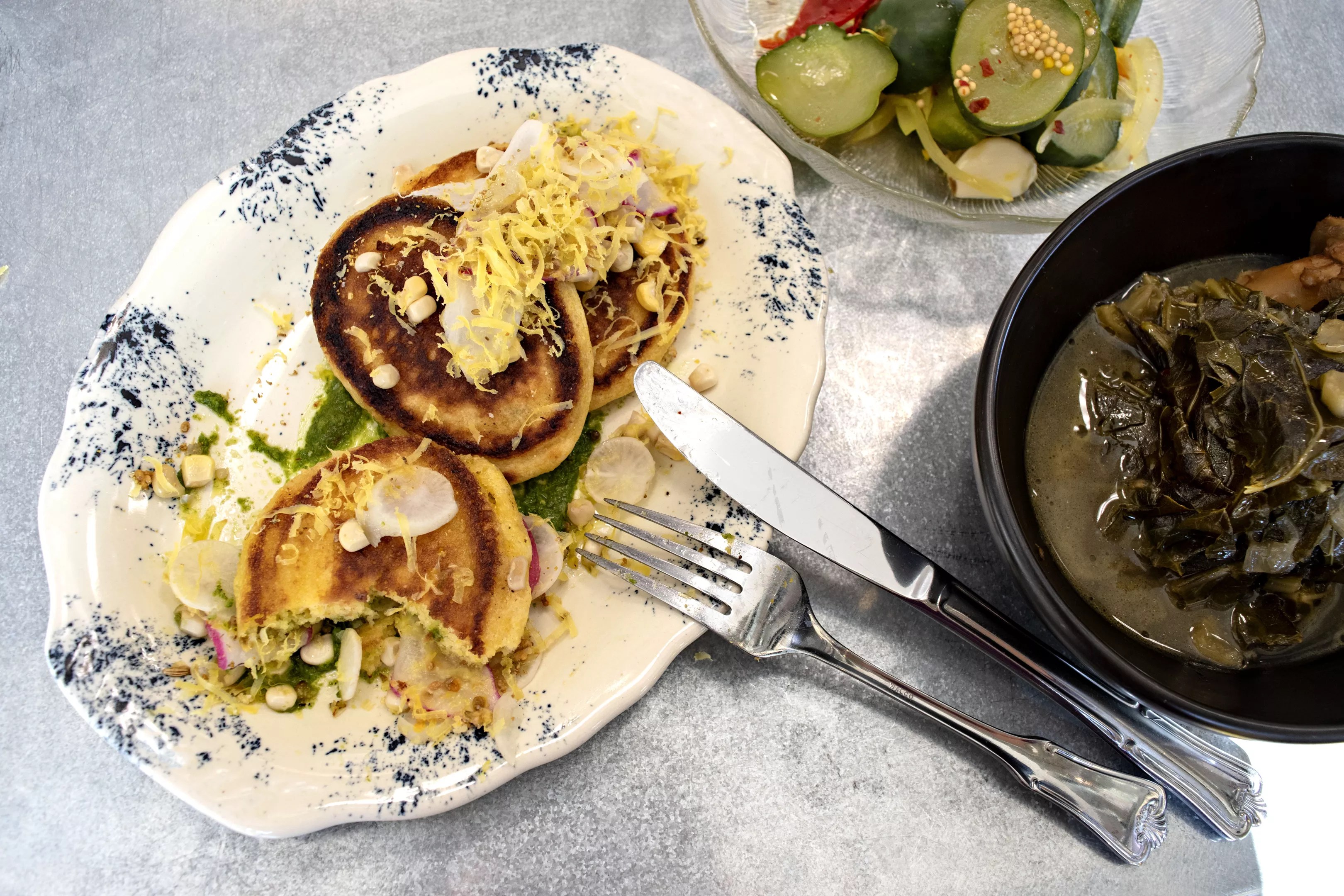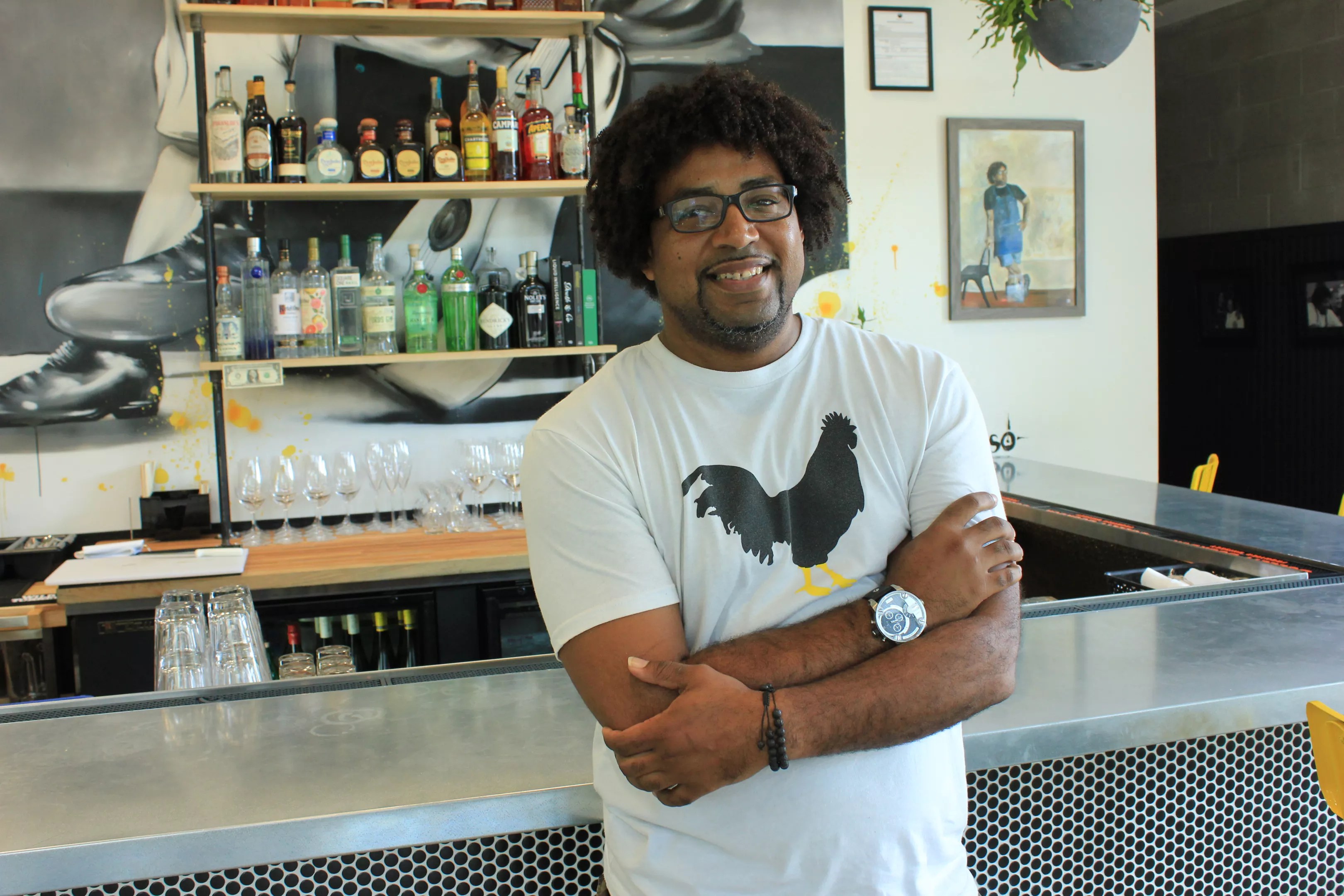
Jackie Mercandetti

Audio By Carbonatix
I. As pickles. Stephen Jones makes cucumber pickles like pucks. They are thick with a compact, sliding bite, like gumdrops without sugar. As raw cucumbers from Abby Lee Farms they begin life. Jones transforms these humble vegetables from the gourd family using apple cider vinegar and spices into discs with bewildering musk, heady tang, and alien chew. They are so good that if somebody ever breaks into the Larder + the Delta, Jones’ new restaurant on West Portland Street, they might take nothing but pickles.
II. As the absence of bourbon. After water, corn is the primary ingredient in bourbon. Bourbon is the spirit of the South. Once upon a time, before cars and Eisenhower’s highways, Southern farmers would turn surplus corn into whiskey so it wouldn’t spoil. Jones runs a Southern restaurant that, on one recent night, served seven cocktails. None used bourbon.
III. As the architrave of a new cooking style. Stephen Jones operates within a national movement of chefs in cities like Seattle; Nashville, Tennessee; and Charleston, South Carolina, who twist and elevate Southern cuisine, altering notions of what Southern food can be. He calls this line of deeply American culinary evolution New Southern.
Growing up in Los Angeles and Chicago, Jones often visited family in Alabama. Once, he rambled the South for about four months, simply eating, watching people cook, and making friends. He loved exploring the Mississippi Delta.

Stephen Jones relaunched The Larder + the Delta.
Chris Malloy
This was why, after culinary school, after a run as sous chef at Nobu in Las Vegas, after riding early ripples of New Southern at the bygone Sin City restaurant Bradley Ogden, Jones named his counter in DeSoto Central Market the Larder + the Delta. Crowds flocked. In an effort to meet demand, Jones closed and spent a year reincarnating the Larder + the Delta in its new, sleek, higher-volume space in downtown Phoenix.
He opened the Larder again in July. Crowds flocked once more.
The Larder gives Phoenix eaters, used to soul food joints built on fried chicken and catfish, a new way of seeing vegetables: as the architrave of a modern southern restaurant.
IV. As a gambit. Jones cooks Buffalo “chicken” cauliflower, swapping out white bird for white plant. With cauliflower from McClendon Selects starring, the preparation turns into a dish of finesse. The crisp fry on the florets has a light quality, a nuttiness that unspools into similarly delicate zones of flavor as the tender cauliflower. Smoked bleu cheese and pickled celery slices carry the twist further, slashing in from different directions. A slurry blended from clarified butter and two Cutino Sauce Co. sauces, jalapeno and habanero, builds a current of clean, rich heat.
And not for a heartbeat do you miss chicken.
V. As an ash. In the nakedly open kitchen of the Larder + the Delta, vegetable bits and scraps, like onion skins, are combined and burned to ash. This ash is used as spice or garnish – on meatless dishes like tamales and beignets.
VI. As an overlooked waste product. Sitting at the embossed metal bar that runs the length of the dining room, under lazily twirling fans and a ceiling to the sky, you might discover some new tunes, like “Autumns Evening Breeze” by Sound Providers. You might also discover some new vegetables, like parsley root.
Jones roasts parsley roots, which knob and gnarl like carrots, in brined hay. He studs them in an ornately silky puree of smoked celery root (the smoke distant), topped with lacy streusel made from benne seeds – a crop first brought to America through the trans-Atlantic slave trade – for some crunch. You have to cut rounds of the parsley root yourself. Your knife glides in with ease. The hot pieces have a flavor almost like sunflower seeds and a soft, meaty texture that, together with the cool puree, is almost unbelievable.
This vegetable dish, made from a forlorn plant part, is Jones’ best.
VII. As scraps that are gold. Jones claims to run a zero-waste kitchen. He grinds corn husks left over from tamales and infuses them into crema; he turns herb stems and leaf bits into green goddess dressing. He sees vegetable detritus as sculptors see stone. This exigency is a vestige from centuries past, a nod back to the South of slavery, where Jones often turns for culinary inspiration.

Larder + Delta’s hoe cakes
Jackie Mercandetti
VIII. As Southern history. Jones sees vegetables as conduits to the past. He cooks Hoppin’ John, an old Southern dish of rice and peas, using Carolina Gold Rice and Sea Island Red Peas, two heirloom crops. The peas are more like beans. Jones simmers them simply, and they have a simple richness that fits a warm, soothing rice dish. Trying to capture the spirit of rice cooked over outdoor fires, Jones lets grains char against the modern metal he uses. Crisp clusters have a jaunty crunch that recalls bibimbap.
IX. As objects of sublime beauty. At Jones’ restaurant, hoecakes, old-time savory cornbread pancakes, come draped with thin slices of Easter egg and icicle radishes. Jones and his team, who move coolly in the open kitchen, sliver the whole radish from top to tendril. The shaved radishes are virtually two-dimensional and visually arresting. Better still, they have functions beyond optical aesthetics in the greater dish: peppery tingle, faint earth, cool snap.
X. As the bones of hoecake. In shaping hoecakes, Jones uses cornmeal milled by Jason Raducha of Noble Bread. These granules lend coarseness and intense spirit to the puffy cakes, which line the plate in a yellow trio, brown and lacy where batter kissed cast-iron. Lavender and lemon also slumber within. Not much – just enough to appear as dim hints of something different.
The hoecakes are topped with radish slivers, celery leaves, cured egg yolks, and sel gris (coarse salt). Lime-green bursts of celery salsa verde hide under the puffy cakes. The dish’s hefty salt can bludgeon in some bites, but in others everything yields a light, complexly vegetal, elegant riff on an old workaday meal.

Chef Stephen Jones combs his memories of Greenville, Mississippi, to create a new version of the tamales brought to town by Mexican immigrants.
Jackie Mercandetti
XI. As mole for Southern tamales. Jones combs his memories of Greenville, Mississippi, to create a new version of the tamales brought to town by Mexican immigrants, who settled by the delta. He braises tamales made not of masa but fresh cornmeal, Crow’s Dairy feta, and vegetables like mustard green stems, collards, and mushrooms. One of the sauces sluiced colorfully on the plate is a mole made from cacao, dried apricots, three kinds of chile peppers, bell peppers, and spinach.
The mole is nice, but won’t dazzle in a metropolis so close to Mexico. In addition, a blunt, unalloyed chile heat overwhelms at times. With some tweaking, these tamales could be a signature.
XII. As a conduit for gentle smoke. Before smoked sweet potatoes are turned into the meat of a pie, their skins are peeled and dehydrated. Later, they are deployed on your slice, conveying a gentle smoke.
XIII. As a canvas. This sweet potato pie isn’t sweet and isn’t about potatoes. What you taste is its other components: almond powder (for crunch) and a hypnotically delicious burnt cinnamon meringue. Sweet potatoes are a canvas for the hot meringue. Fork that gloppy ambrosia all over your orange slice.
Vegetables, too, can be a canvas on another level: for a cooking philosophy.
Jones says he cooks vegetable-driven New Southern, and that this sets him apart from other pioneering Southern chefs across the nation. True, he cooks fried chicken and pork chops and swordfish, but the largest swath of his menu is prime real estate owned by vegetables.
Given what sets Jones apart, given that he hopes to carve his niche within New Southern on a national level, judging him on nothing but vegetables seems a hard curve, but a fitting one.
The Larder + the Delta is one of the most exciting restaurants in metro Phoenix. Though Jones makes mistakes, the poetic spirit that suffuses his food more than makes up for the occasional ambitious idea that doesn’t fully translate from imagination. And he will only get better as his ideas evolve, as he settles into his new space, and as his mind keeps humming with, lucky for us, new ways of seeing vegetables.
The Larder + The Delta
200 West Portland Street, #101
480-409-8520
Hours: Tuesday to Thursday from 11 a.m. to 10 p.m.; Friday from 11 a.m. to midnight; Saturday from 4 p.m. to midnight; Sunday from 9 a.m. to 3 p.m.
Parsley root $10
Hoe cakes $11
Hoppin’ John $12
Buffalo “chicken” cauliflower $10
Sweet potato pie $10